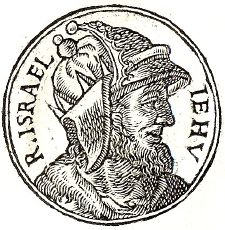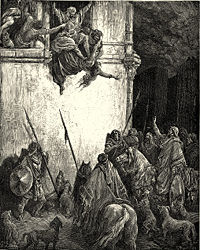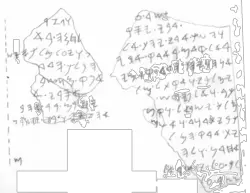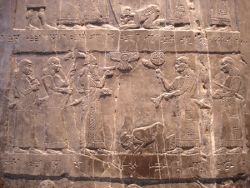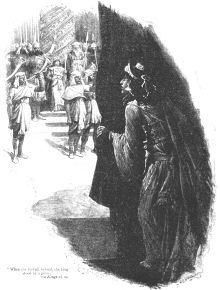Jehu
Jehu (יְהוּא, Yehu—"The Lord is he") was king of Israel, 842–815 B.C.E. He assumed the throne after being anointed by a messenger of the prophet Elisha and carried out one of history's most violent coups. In the process he killed both the reigning King of Israel, Joram, and the King of Judah, Ahaziah, at the same time. An adamant opponent of Baal worship, Jehu also murdered the infamous Queen Jezebel, Joram's mother, whom the prophets blamed for the resurgence of Baal in Israel, and went on to slaughter dozens of her husband Ahab's sons, as well as numerous members of the royal house of Judah. He ended his coup by gathering the priests of Baal in their temple in the city of Samaria and killing them all. While the Bible strongly praises Jehu for these acts, the Book of Kings—our principal source for the events of his reign—criticizes him for failing to destroy the Israelite shrines at Bethel and Dan which competed with the Temple of Jerusalem for the loyalty of Israel's worshipers.
As king, Jehu's military record was not nearly as successful as his immediate predecessors against the Syrians, and he lost considerable territories to the Hazael of Damascus. Outside the Bible, Jehu is depicted on the Black Obelisk of Shalmanezzer III as prostrating himself and offering tribute before the Syrian king. The recently discovered Tel Da inscription contradicts some of the main events in the biblical story of Jehu, giving credit to Hazael for some of Jehu's most famous deeds.
While the Book of Kings considers Jehu one of Israel's few good kings, the prophet Hosea appears to denounce his coup and to predict that God would strongly punish Israel for Jehu's violent deeds.
Biography
Background
Jehu's story is cast against the background of the reign of the Omride dynasty, consisting of Omri, Ahab, and Ahab's two sons, Ahaziah and Joram/Jehoram.[1] These kings, especially Ahab, were considered evil by the biblical writers because of their tolerance of Baal worship.[2] While each of these kings seems to have honored Yahweh personally, they also allowed and even supported Baal worship, in part because of the influence of Ahab's wife Jezebel, who was not an Israelite but a Phoenician princess. Although some of the prophets had occasionally supported Ahab and his sons in their battles against Syria, in Jehu's time, a militant Yahweh-only faction led by the prophet Elisha had emerged as a significant political faction opposed to the Omrides. This faction may also have been critical of the southern royal house of Jehoshaphat of Judah, who allied himself with Ahab against the Syrians and allowed Ahab and Jezebel's daughter Athaliah to marry into the Davidic lineage.
So strong was the opposition of the prophets to Ahab's line that they resolved to inspire a violent coup against his descendants, even conspiring with the Syrians in the effort. In 1 Kings 19, God had commissioned Elijah to anoint Jehu as the new king of Israel and to anoint Hazael as the new king of Syria. A violent result is clearly envisioned:
- Go to the Desert of Damascus. When you get there, anoint Hazael king over Aram (Syria). Also, anoint Jehu son of Nimshi king over Israel, and anoint Elisha son of Shaphat from Abel Meholah to succeed you as prophet. Jehu will put to death any who escape the sword of Hazael, and Elisha will put to death any who escape the sword of Jehu. (1 Kings 19:15-17)
Elijah, however, had left this task unfulfilled, and it was left to Elisha to accomplish it.
Jehu's call
Jehu's story begins when he was serving as a commander of chariots under Joram after the battle of Ramoth-Gilead against the army of the Syrians. There, Joram (also called Jehoram) had been wounded and returned to Jezreel to recover. Joram's ally and nephew, King Ahaziah of Judah,[3] had also gone to Jezreel to attend Joram (2 Kings 8:28). While the commanders of the army were assembled at Ramoth-Gilead, the prophet Elisha sent one of his disciples to anoint Jehu as the future king of Israel.[4] The messenger found Jehu meeting with other officers and led him away from his peers. Pouring oil on Jehu's head, the young prophet declared God's words:
- You are to destroy the house of Ahab your master, and I will avenge the blood of my servants the prophets and the blood of all the Lord's servants shed by Jezebel. The whole house of Ahab will perish. (2 Kings 9:1-10).
Jehu's companions, inquiring after the object of this mysterious visit, greeted the news of prophetic support for Jehu with enthusiasm, blowing a trumpet and cheering him as king (2 Kings 9:11-14).
Jehu's coup
Jehu and his supporters promptly rode to Jezreel, where Joram was recovering from his wounds. "Do you come in peace, Jehu?" the king asked. Jehu replied: "How can there be peace, as long as all the idolatry and witchcraft of your mother Jezebel abound?" Jehu then shot Joram in the back with an arrow as he turned to flee. Jehu also ordered the murder of Ahaziah in the coup.
Seeing his duty to destroy the entire "house of Ahab," Jehu turned next to Joram's monther Jezebel, Ahab's widow. The queen-mother died after being thrown down from a high window by her own eunuchs at Jehu's command. Following this, Jehu engineered the killing of 70 of Ahab's male descendants, ordering their heads left in piles at the gates of Jezreel.
Turning toward the northern capital of Samaria, Jehu encountered 42 relatives of Ahaziah coming from Judah to pay their respects to Joram and Jezebel. These too, he slaughtered. Arriving at Samaria, Jehu continued the bloodbath: "He killed all who were left there of Ahab's family." (2 Kings 10:17)
Carrying Elisha's program to its logical conclusion, Jehu then summoned the priests of Baal, whom Joram had tolerated, to a solemn assembly in the capital. His invitation declared: "Ahab served Baal a little; Jehu will serve him much." Once they assembled in Baal's temple, Jehu—supported by the Yahwist partisan Jehonadab son of Recab—proceeded to order them all slaughtered, demolishing the temple, and turning it into a public latrine.
Jehu as king
Despite his uncompromising zeal for Yahweh, Jehu's reign does not receive the complete endorsement of the pro-Judah authors of the Books of Kings. He is particularly criticized for failing to destroy the shrines at Dan and Bethel, which competed with Judah's central shrine at Jerusalem.[5] Nevertheless, the biblical writers preserve a prophecy in which God tells Jehu:
- Because you have done well in accomplishing what is right in my eyes and have done to the house of Ahab all I had in mind to do, your descendants will sit on the throne of Israel to the fourth generation. (2 Kings 10:30)
The prophet Hosea, on the other hand, took the opposite view to that of the authors of Kings, indicating that God would not reward but would instead punish the House of Jehu for the slaughter of Ahab's family at Jezreel. Indeed, Hosea's prophecy seems to indicate that Jehu's actions at Jezreel would be responsible for the ultimate destruction of Israel as a kingdom:
- So he married Gomer daughter of Diblaim, and she conceived and bore him a son. Then the Lord said to Hosea, "Call him Jezreel, because I will soon punish the house of Jehu for the massacre at Jezreel, and I will put an end to the kingdom of Israel." (Hosea 1:3-4)
Militarily, Jehu's severing of Israel's alliance with Judah left him hard pressed by Hazael of Syria. Paradoxically, this enemy of Israel himself had been anointed to his office by none other than the prophetic kingmaker Elisha. Adding to the complications in unraveling the mystery of the "historical" Jehu is the fact that the Tel Dan Stele, discovered in 1993-1994 gives the credit for killing Joram and Ahaziah to a Syrian king, apparently Hazael. This leads some commentators to suggest that Jehu may have even acted as Hazel's agent in the destruction of Ahab's dynasty.
In any case, the biblical account admits that Jehu's army was defeated by Hazael "throughout all of the territories of Israel" beyond the Jordan river, in the lands of Gilead, Gad, Reuben, and Manasseh (10:32). In this desperate state of affairs, Jehu may have turned to the emerging Assyrian power for support. This would explain why the one extra-biblical mention of Jehu, the the Black Obelisk of Shalmaneser III, depicts him as humbly offering tribute to the Assyrian king.
Who Jehu is not
It is easy to confuse Jehu with another, roughly a contemporaneous biblical figure of the same name, and also to confuse his lineage with the royal lineage of Judah.
Jehu should not be confused with the Jehu the son of Hanani, a prophet active both before and during the reign of Jehoshaphat of Judah and who criticized Jehoshaphat for his alliance with Ahab (2 Chron. 19: 2-3).
Jehu was the son of a man named Jehosophat, son of Nimshi. This was not the Jehoshaphat who reigned as king of Judah a generation or two earlier. The royal Jehoshaphat of Judah was the father of King Joram/Jehoram of Judah and the grandfather of Ahaziah of Judah, whom Jehu ordered slain during his coup against Joram of Israel. To make matters even more confusing, both the Kingdom of Israel also had kings named Ahaziah and Joram/Jehoram during roughly the same period.
Jehu's legacy
Jehu's ascension to the throne marked a turning point in the history of the northern kingdom. Externally, Israel had always been the more powerful of the two "Israelite" states, while Judah had been the more strongly devoted to Yahweh.
Suddenly, however, the spiritual tables were turned. Under Jehu, Baal worship was violently suppressed in Israel. However, Jehu's murder of Ahaziah of Judah at Jezreel unwittingly paved the way of Ahaziah's grandmother, Athaliah, to seize the throne in Jerusalem. The daughter of none other than Jezebel, the nemesis of Jehu's patron Elisha, Athaliah carried out a bloodbath of her own in the southern capital. She also reportedly either constructed or patronized a temple of Baal in the holy city itself. The only reigning queen in the history of either Judah or Israel, her rule lasted six years until she was slain in a counter coup engineered by the Yahwist priests of the Temple of Jerusalem, who put her great-grandson Joash on the throne in her place.
Politically, by ending the former alliance between Israel and Judah which had fared well against the Syrian power, Jehu left himself vulnerable to forces of Hazael, who succeeded in conquering significant portions of the small empire built under the Omride dynasty. For protection, Jehu was forced to humble himself before Shalmaneser III of Assyria, an act notoriously memorialized in the Black Obeslisk.
Nevertheless, under Jehu's son Jehoahaz, Israel was reduced to a vassal state of Damascus. After the death of Hazael, Assyria moved against Damascus again. This enabled Jehoahaz' son Joash (also called Jehoash to distinguish him from the Judean king of the same name) to defeat Damascus' new king, Ben-hadad III, and recapture lost territory. He also struck against the Kingdom of Judah, where he reportedly sacked Jerusalem and looted its Temple (2 Kings 14).
Israel reached the zenith of its power after the ascension of Jeroboam II (c. 783), who recaptured substantial Syrian and transjordanian territories and made Israel an even greater power than it had been in the days of the Omride dynasty. However, this external glory was short-lived. Affluence gave rise to moral corruption, which was eloquently decried in the oracles of the literary prophets Amos and Hosea, the latter of whom declared Jehu's massacre in Jezreel to have been counter to God's will, dooming the northern kingdom to ultimate destruction.
| Preceded by: Jehoram (Joram) |
Jehu, King of Israel Albright: 842 B.C.E.– 815 B.C.E. Thiele: 841 B.C.E.– 814 B.C.E. Galil: 842 B.C.E.– 815 B.C.E. |
Succeeded by: Jehoahaz |
Notes
- ↑ Not to be confused with the two kings of the same name who ruled in Judah during the same era.
- ↑ Another issue the prophets had against Ahab was his mistreatment of a man named Naboth, whose property Ahab usurped after having him killed. Naboth is mentioned several times in the Jehu narrative, and it is in Naboth's field that Jehu ends up assassinating Ahab's son Joram.
- ↑ Not to be confused with Ahaziah of Israel, who was Joram's brother and immediate successor.
- ↑ A rabbinical tradition holds that this young man was the future prophet Jonah. (See Book of Jonah.)
- ↑ Most scholars believe these shrines honored Yahweh, although the biblical writers make much of the golden calf icons which these sites featured.
ReferencesISBN links support NWE through referral fees
- Bright, John. A History of Israel. Westminster John Knox Press; 4th edition, 2000. ISBN 0664220681
- Dutcher-Walls, Patricia. Jezebel: Portraits of a Queen. Michael Glazier Books, 2004. ISBN 978-0814651506
- Galil, Gershon. The Chronology of the Kings of Israel and Judah. Leiden: Brill Academic Publishers, 1996. ISBN 9004106111
- Grant, Michael. The History of Ancient Israel. Charles Scribner's Sons, 1984. ISBN 0684180812
- Keller, Werner. The Bible as History. Bantam, 1983. ISBN 0553279432
- Lowrie, John M. The Prophet Elisha. Reprint Series. Scholarly Publishing Office, University of Michigan Library, 2005. ISBN 9781425527532
- Miller, J. Maxwell. A History of Ancient Israel and Judah. Westminster John Knox Press, 1986. ISBN 066421262X
External links
All links retrieved December 23, 2024.
Credits
New World Encyclopedia writers and editors rewrote and completed the Wikipedia article in accordance with New World Encyclopedia standards. This article abides by terms of the Creative Commons CC-by-sa 3.0 License (CC-by-sa), which may be used and disseminated with proper attribution. Credit is due under the terms of this license that can reference both the New World Encyclopedia contributors and the selfless volunteer contributors of the Wikimedia Foundation. To cite this article click here for a list of acceptable citing formats.The history of earlier contributions by wikipedians is accessible to researchers here:
The history of this article since it was imported to New World Encyclopedia:
Note: Some restrictions may apply to use of individual images which are separately licensed.
